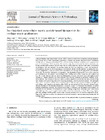Decellularized extracellular matrix particle-based biomaterials for cartilage repair applications
Abstract
Cartilage Decellularized ExtraCellular Matrix (dECM) materials have shown promising cartilage regeneration capacity due to their chondrogenic bioactivity. However, the limited retention of ECM components and the reduced integrity of functional ECM molecules during traditional decellularization processes impair the biomimicry of these materials. The current study aims to fabricate biomimetic materials containing decellularized cartilage particles that have an intact molecular structure and native composition as biomaterial inks and hydrogels for cartilage repair. For this, we established a novel two-fraction decellularization strategy for the preparation of reconstituted dECM (rdECM) particles by mixing the two-fraction components, as well as a one-fraction decellularization strategy for the preparation of biomimetic dECM (bdECM) particles. Hyaluronic acid-tyramine (THA) hydrogels containing rdECM or bdECM particles were produced and characterized via rheological test, swelling and stability evaluation, and compression test. The results showed that our novel decellularization strategies preserved intact proteoglycans and collagen at a higher retention rate with adequate DNA removal compared to traditional methods of decellularization. The addition of rdECM or bdECM particles significantly increased the shear moduli of the THA bioinks while preserving their shear-thinning properties. bdECM particle-embedded THA hydrogels also achieved long-term stability with a swelling ratio of 70% and high retention of glycosaminoglycans and collagen after long-term incubation, while rdECM particle-embedded THA hydrogels showed unsatisfactory stability as self-standing biomaterials. Compared to pure THA hydrogels, the addition of bdECM particles significantly enhanced the compression moduli. In summary, our decellularization methods are successful in the retention of functional and intact cartilage components with high yield. Both rdECM and bdECM particles can be supplemented in THA bioinks for biomimetic cartilage 3D printing. Hydrogels with cartilage bdECM particles possess the functional structure and the natural composition of cartilage ECM, long-term stability, and enhanced mechanical properties, and are promising biomaterials for cartilage repair. Show more
Permanent link
https://doi.org/10.3929/ethz-b-000614589Publication status
publishedExternal links
Journal / series
Journal of Materials Science and TechnologyVolume
Pages / Article No.
Publisher
ElsevierSubject
Cartilage tissue engineering; Decellularized extracellular matrix; Proteoglycan integrity; Biomimetic hydrogels; Biomaterial; BioinkFunding
189310 - INDEED - Engineered full-organ 3D intervertebral disc as standardized model for studying disc degeneration and disease (SNF)
More
Show all metadata



